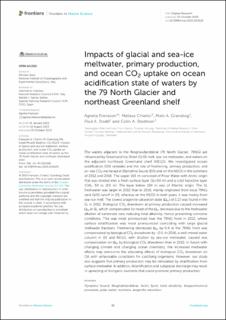| dc.description.abstract | The waters adjacent to the Nioghalvfjerdsbræ (79 North Glacier, 79NG) are influenced by Greenland Ice Sheet (GrIS) melt, sea-ice meltwater, and waters on the adjacent northeast Greenland shelf (NEGS). We investigated ocean acidification (OA) variables and the role of freshening, primary production, and air-sea CO2 exchange in Dijmphna Sound (DS) and on the NEGS in the summers of 2012 and 2016. The upper 150 m consisted of Polar Water with Arctic origin that was divided into a fresh surface layer (SL<50 m) and a cold halocline layer (CHL, 50 to 150 m). The layer below 150 m was of Atlantic origin. The SL freshwater was larger in 2012 than in 2016, mainly originated from local 79NG (and GrIS) runoff in DS, whereas on the NEGS in both years, it was mainly from sea-ice melt. The lowest aragonite saturation state (ΩAr) of 1.13 was found in the SL in 2012. Biological CO2 drawdown at primary production caused increased ΩAr in SL, which compensated for most of the ΩAr decrease due to the freshwater dilution of carbonate ions reducing total alkalinity, hence preventing corrosive conditions. This was most pronounced near the 79NG front in 2012, where surface stratification was most pronounced coinciding with large glacial meltwater fractions. Freshening decreased ΩAr by 0.4 at the 79NG front was compensated by biological CO2 drawdown by ~0.5. In 2016, a well-mixed water column in DS and NEGS, with dilution by sea-ice meltwater, caused less compensation on ΩAr by biological CO2 drawdown than in 2012. In future with changing climate and changing ocean chemistry, the increased meltwater effects may overcome the alleviating effects of biological CO2 drawdown on OA with unfavorable conditions for calcifying organisms. However, our study also suggests that primary production may be stimulated by stratification from surface meltwater. In addition, Atlantification and subglacial discharge may result in upwelling of inorganic nutrients that could promote primary production. | |
